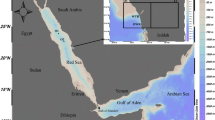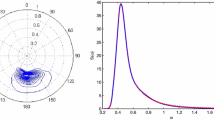Abstract
Long ocean waves with periods of several minutes (surf-beats) were observed at a marine observation tower. We have analysed time series data of an envelope of incident swell, long period current velocity and surface elevation fluctuations. Current velocity was measued by an electromagnetic flow meter. Surf-beats amplitudeH (l) is shown to be proportional to 3/2 power of incident swell amplitudeH (s), and decreases with increase of depthh in proportional toh −1/2 such thatH (l) ∼H (s) (H (s)/h)1/2. Frequency energy density functionP LL (f) of surface elevation had two dominant peaks whose frequencies were highly stable through the entire observational period. Cross-spectral analysis suggested that those peaks correspond to traveling edge waves caused by the excess momentum and mass flux in the surf zone. The forced long ocean waves predicted byLonguet-Higgins andStewart (1964) was ditected. Phase-shift and wave height of the wave with respect to those of incident swell envelope are shown to be in remarkable agreement with the predictions. However the forced long wave is only a minor component in the total energy of surf-beats. Current fields are shown to be largely composed of non-surface modes.
Similar content being viewed by others
References
Bowen, A. J. (1969): Rip Currents, 1. J. Geophys. Res.,74, 5467–5478.
Gallagher, B. (1971): Generation of surf beat by non-linear wave interaction. J. Fluid Mech.,49, 1–20.
Goda, Y. (1975): Rep. of Port and Harbour Res. Inst.14, 59.
Guza, R. T. andA. J. Bowen (1976): Finite amplitude edge waves. J. Mar. Res.,34, 269–293.
Hasselmann, K. (1962): On the non-linear energy transfer in a gravity wave spectrum Part 1. J. Fluid Mech.,12, 481–500.
Hasselmann, K. (1971): On the mass and momentum transfer between short gravity waves and longer-scale motions. J. Fluid Mech.,50, 189–205.
Longuet-Higgins, M. S. andR. W. Stewart (1964): Radiation stresses in water waves; a physical discussion, with application. Deep-Sea Res.,11, 529–562.
Munk, W. H. (1949): Surf beats. Trans. Amer. Geophys. Uni.,30, 849–854.
Munk, W. H. (1962): Long ocean waves.In, The Sea, Interscience, New York, pp. 647–663.
Nagata, Y. (1964): Observation of the directional wave properties. Coastal Engine. in Japan,7, 11–29.
Reid, R. O. (1958): Effect of coliolis force on edge waves (I). Investigation of the normal modes. J. Mar. Res.,16, 109–144.
Suhayda J. N. (1972): Experimental study of the shoaling transformation of waves on a sloping beach. Ph. D. dissertation, Univ. California.
Takahashi, T.,Suzuki, Y.,Sasaki, H. andNakai, T. (1971): Data of Port and Harbour Res. Inst. No. 130.
Tucker, M. J. (1950): Surf beats; sea waves of 1 to 5 min. Period. Proc. Roy. Soc. A,202, 565–573.
Witham, G. B. (1976): Nonlinear effects in edge waves. J. Fluid Mech.,74, 353–368.
Author information
Authors and Affiliations
Rights and permissions
About this article
Cite this article
Fujinawa, Y. Some properties of surf-beats. Journal of the Oceanographical Society of Japan 35, 9–25 (1979). https://doi.org/10.1007/BF02108278
Received:
Revised:
Accepted:
Issue Date:
DOI: https://doi.org/10.1007/BF02108278




